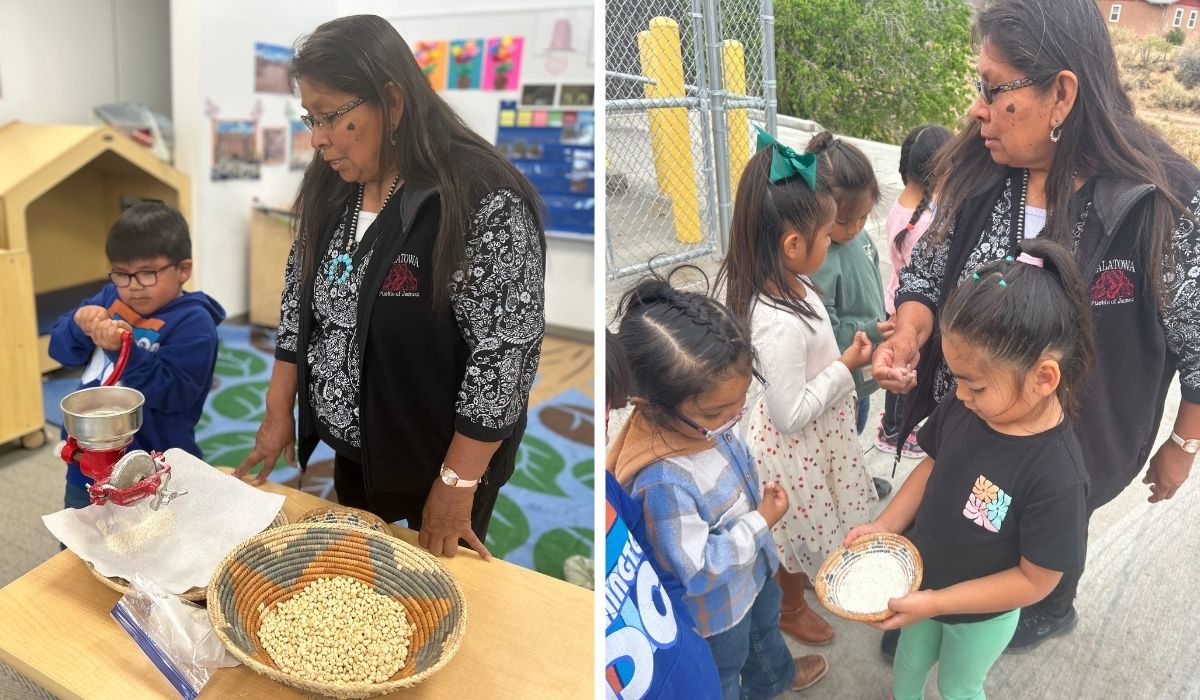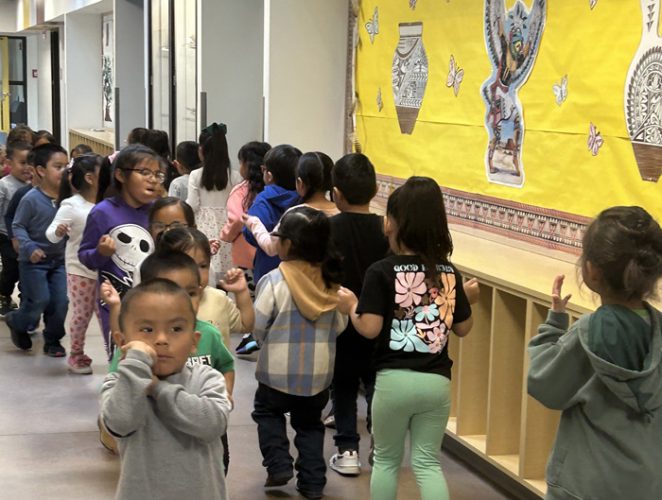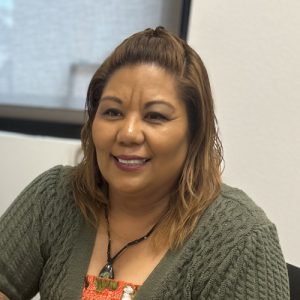For Some Tribal Communities, Head Start Programs Provide a Cultural Lifeline
The Walatowa Head Start program is protecting and preserving tribal language and culture on the Pueblo of Jemez in New Mexico.
By Rebecca Gale | June 23, 2025It’s 9 a.m. in the morning and the children at the Walatowa Head Start Early Childhood Learning Center on the Jemez Pueblo in New Mexico, line up outside, each carrying a small amount of cornmeal in their hands. Bertha Gachupin, one of the teachers, leads the children as they say their Native American name, the name of their clan, and then a prayer to learn and understand the Hemish language and have a good day at school, before blowing the cornmeal from their palms.
When finished, they rub the remaining cornmeal dust over their hands and heart. “It gives them strength,” Gachupin said. Cornmeal is sacred to the Jemez, a federally recognized tribe, she explains. Each classroom has a cast-iron grinder attached to a desk with baskets of corn next to it. “Whenever it’s getting low, without even telling them, [the children] will go to the machine and start grinding it,” she said.
The morning prayer and grinding of cornmeal are two of the many traditions 3- to 5-year olds learn at Walatowa’s Head Start, where Gachupin has taught for over 25 years. The entire program is conducted in Hemish (which linguists also refer to as Hemish-Towa, or Towa), the oral language of the Pueblo of Jemez, as part of an effort to preserve the community’s language, history and culture.

Native American citizens represent about 12% of the population in New Mexico, and 23 tribes live on sovereign land, like the Jemez Pueblo. Of the 34 Head Start and Early Head Start programs in New Mexico, half are on tribal lands; Walatowa is one of three that implements a formal language immersion program (the other two are Saad K’idilyé Language Nest in Albuquerque and Keres Children’s Learning Center at Cochiti Pueblo).
Over the past five years, New Mexico has made significant investments in early care and education, including expanding its funding, creating an early childhood department in the state government and most notably, becoming the first state to guarantee a right to early childhood education. The state is also supporting programs that protect and preserve tribal languages and culture, including the New Mexico Indigenous Languages initiative, Native Language Database and Grow Your Own Indigenous Language Teacher Pipeline. Some of the state’s Head Start programs are also prioritizing preserving tribal culture in their work with young children and families.
Head Start is a free, federally funded child care program designed to serve children from low-income families by providing high-quality care so parents can work and offering early learning opportunities that get young children ready for school. The Trump Administration indicated it would zero out funding for Head Start, before reversing course in May. But for tribal communities like Jemez, Head Start provides more than just child care and school readiness, it creates a lifeline to their cultural identity, which generations have tried to take from them.
“The reality of language loss has really scared us,” said Lana Garcia, the executive director of the Walatowa Head Start, who grew up speaking the Hemish language with her mother and grandmother at home. While Garcia spoke Hemish at home, she attended English-speaking schools, learned to read in English and was an English major in college before becoming a teacher in a local public school near Albuquerque. She moved back to Jemez in 2007 to lead the Walatowa program. Garcia recalls her own daughter asking her why she’d never been taught the language. “It was painful,” she said, adding that for so long, she’d assumed English had been the better language to learn.
The reality of language loss has really scared us.
Lana Garcia, executive director of the Walatowa Head Start
Facilitating the language immersion program at the Walatowa Head Start has clarified for Garcia that young children can keep alive through the history and customs of their tribe. The curriculum is filled with activities specific to Jemez culture: customary songs and dances, story hour led by local elders, and traditional meals like atole, a blue corn drink served hot, Jemez enchiladas and frybread. The staff speak Hemish to one another and to the children. When Garcia answers a call in her office, she does so in Hemish, before switching to English if and when the caller requires it.

It’s not uncommon among tribes for a language to be oral-only, like Hemish. Garcia explained that Hemish is considered sacred, and they do not have permission from tribal leaders to write it. “Our language is really tied to our ceremonies,” she explained.
Because Head Start is federally funded, decisions about its future are made in Washington, not in Santa Fe. While federal funding covers 80% of the cost of each Head Start program, the local community is responsible for coming up with the remaining 20%, and according to Garcia, she must plan carefully because operating a Head Start program on tribal land comes with additional costs. A bus driver is needed to transport the children to and from school, and the routes’ unpaved roads can lead to more repairs, which she must budget for. An enrollment decline has also created challenges. Before COVID, Walatowa served 70 children, and now it serves 57, meaning less federal money flowing to the program.
Even though New Mexico has allocated significant funding for child care, there are no additional funds for Walatowa to operate should Head Start face federal cuts. The tribal government has no spare money — there is no back up plan to stay afloat. According to Garcia, the funding uncertainty has caused panic in her community. Before the administration pivoted from its plan to eliminate funding, Garcia said: “The fact that Trump has allocated zero funds to the Office of Head Start in the 2026 budget, that is alarming for a lot of us.”
But what Garcia does have is a strong success record of keeping the Hemish language and culture alive. Some of the skills the children receive from watching and taking part in Hemish ceremonies — such as having a longer, focused attention span — will help them throughout their education.

“When we watch our dances, it is all day,” said Garcia. “You’re expected to sit and watch. Those expectations are given to us by the War Captains that you stay for the whole day. You stay until the very end.”
As children have grown and graduated from Head Start, many have kept a strong connection to the Hemish culture and language. With pride, Garcia recalled seeing several boys who graduated the program take a prominent singing role during a tribal ceremony, and witnessing a child who insisted on going to the ceremony celebration on his own, even though his parents didn’t participate.
“Success is students who know who they are and where they come from and know how they can contribute to their community — that is the Jemez way of life,” she said.
This work is supported by a child care reporting grant at the Better Life Lab. More details on the reporting grants can be found here.
Get stories like these delivered straight to your inbox. Sign up for The 74 Newsletter


